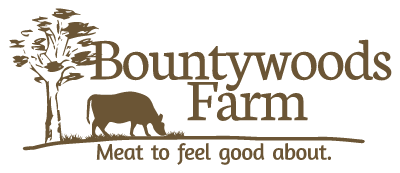 100% grass fed beef doesn’t always want to be that way..
100% grass fed beef doesn’t always want to be that way..
Several weeks ago we had an episode of bovine rebellion happen right in broad daylight – and at our Open Farm Day of all times! (gulp.) Our yearling heifer that has been raised on only pasture, hay, and her mother’s milk, was found on one of the tours..right inside one of our chicken shelters..cheerfully eating the chickens’ grain! The chickens, although a little ruffled, were trying to live with the disturbance. I’m sure they believed that we’d see to it that they were reimbursed for the feed that the heifer had nabbed from their feeder.
I chased her out – and latched the door this time. However, the next time we came by, she was in there again! Apparently, she had learned to open the barrel bolt latch with her tongue. So we moved the chicken shelter out of the pasture.
We take pains to never feed grain to our cows.. because grass-fed is best. Not only for the animal itself, but also for us who eat the beef produced from them.
Grass fed = a good life
As is probably obvious, pasture-raised animals have a much better quality of life than feedlot animals. The stench from the manure of scantily bedded, grain-fed animals is an unhealthy environment for them. The outdoor environment is clearly a happier place in the summer months – where they can soak up sunshine, and run in the grass.
Besides, since cows are not designed for grain, the diet of feedlot cattle has to be carefully planned to prevent them from getting sick, essentially from too much grain. Cattle are “ruminants” – they have four stomachs, one of which is called the “rumen”. Their stomachs are able to break down large quantities of forages. A diet high in grain sours in the cow’s stomach and can cause digestive disturbances. On the other hand, grasses, clovers, and forbs such as chicory and dandelion promote the health of pastured ruminant animals, and a healthy animal is happy (just like with humans).
Health benefits of grass fed beef
The benefits that the animal gets from a diet of forages (like grass and hay) translates to a healthier end product for us as well. Studies show that beef cattle that receive even a couple months of grain at the end of their life are likely to have greatly reduced levels of essential fatty acids and antioxidants, and higher overall fat and cholesterol.
- Omega-6 fatty acids are usually lower in grass-fed cows, while Omega-3 is often much higher. This brings a far more balanced ratio of Omega-6 to Omega-3.
- The antioxidants alpha-tocopherol and beta-carotene are higher in grass fed beef.
- Since overall fat is lower in grass fed beef, saturated fat is also usually lower.
- Conjugated linoleic acid (CLA) is much higher in grass fed beef. CLA has been linked with reduced risk of cancers and heart disease.
- Vitamin E is higher in grass fed beef.
An acidifying grain diet also allows e-coli more of a chance to grow. Thus grass-fed beef presents a lower risk of e-coli poisoning than from eating grain-fed beef.
Ecosystem benefits
There’s another important reason to avoid feeding grain to animals that thrive without it. Well-managed pasture-based systems are much healthier for the environment. Grain production can use large amounts of fossil fuels, while pasture requires none.
Large grazing animals have many beneficial effects on the ecosystem. Their hoof action creates a disturbance which helps new seeds to get established. Their pulsed grazing as we move them from paddock to paddock stimulates the vigorous growth of plants and roots, which adds large amounts of carbon to the soil from the air. So instead of burning carbon, grazing helps to store carbon in the soil.
Besides, grasses, legumes and deep-rooted forbs greatly benefit the ecosystem in other ways, including hosting bees, birds, and many other forms of life.
Back to our “naughty beef”
With the coming of autumn also comes the time to “harvest” our grass fed beef heifer. I don’t think she got much harm from a few mouthfuls of organic grain. She seemed to think it was candy! I think she inherited her desire for grain from her mother, who was raised with grain before she came to our farm. (Actually, when left to free-range, cattle do snack on a few seed heads of grain if they find it, then go back to the greens again. However, there’s a safeguard against over-indulging: they can’t just gobble down a huge amount because they have to go find it, one plant at a time. A dense wheat field doesn’t exist in the wild.)
So, for those of you who have been waiting, we’ll have grass fed beef available towards the end of October. 99.9% grass fed that is..
And hopefully we can keep our next grass fed beef animals out of the candy jar.
